Shaoliang Nie
Jack
Pisces: An Auto-regressive Foundation Model for Image Understanding and Generation
Jun 12, 2025Abstract:Recent advances in large language models (LLMs) have enabled multimodal foundation models to tackle both image understanding and generation within a unified framework. Despite these gains, unified models often underperform compared to specialized models in either task. A key challenge in developing unified models lies in the inherent differences between the visual features needed for image understanding versus generation, as well as the distinct training processes required for each modality. In this work, we introduce Pisces, an auto-regressive multimodal foundation model that addresses this challenge through a novel decoupled visual encoding architecture and tailored training techniques optimized for multimodal generation. Combined with meticulous data curation, pretraining, and finetuning, Pisces achieves competitive performance in both image understanding and image generation. We evaluate Pisces on over 20 public benchmarks for image understanding, where it demonstrates strong performance across a wide range of tasks. Additionally, on GenEval, a widely adopted benchmark for image generation, Pisces exhibits robust generative capabilities. Our extensive analysis reveals the synergistic relationship between image understanding and generation, and the benefits of using separate visual encoders, advancing the field of unified multimodal models.
Diversity-driven Data Selection for Language Model Tuning through Sparse Autoencoder
Feb 19, 2025Abstract:Current pre-trained large language models typically need instruction tuning to align with human preferences. However, instruction tuning data is often quantity-saturated due to the large volume of data collection and fast model iteration, leaving coreset data selection important but underexplored. On the other hand, existing quality-driven data selection methods such as LIMA (NeurIPS 2023 (Zhou et al., 2024)) and AlpaGasus (ICLR 2024 (Chen et al.)) generally ignore the equal importance of data diversity and complexity. In this work, we aim to design a diversity-aware data selection strategy and creatively propose using sparse autoencoders to tackle the challenge of data diversity measure. In addition, sparse autoencoders can also provide more interpretability of model behavior and explain, e.g., the surprising effectiveness of selecting the longest response (ICML 2024 (Zhao et al.)). Using effective data selection, we experimentally prove that models trained on our selected data can outperform other methods in terms of model capabilities, reduce training cost, and potentially gain more control over model behaviors.
Unveiling User Satisfaction and Creator Productivity Trade-Offs in Recommendation Platforms
Oct 31, 2024



Abstract:On User-Generated Content (UGC) platforms, recommendation algorithms significantly impact creators' motivation to produce content as they compete for algorithmically allocated user traffic. This phenomenon subtly shapes the volume and diversity of the content pool, which is crucial for the platform's sustainability. In this work, we demonstrate, both theoretically and empirically, that a purely relevance-driven policy with low exploration strength boosts short-term user satisfaction but undermines the long-term richness of the content pool. In contrast, a more aggressive exploration policy may slightly compromise user satisfaction but promote higher content creation volume. Our findings reveal a fundamental trade-off between immediate user satisfaction and overall content production on UGC platforms. Building on this finding, we propose an efficient optimization method to identify the optimal exploration strength, balancing user and creator engagement. Our model can serve as a pre-deployment audit tool for recommendation algorithms on UGC platforms, helping to align their immediate objectives with sustainable, long-term goals.
The Perfect Blend: Redefining RLHF with Mixture of Judges
Sep 30, 2024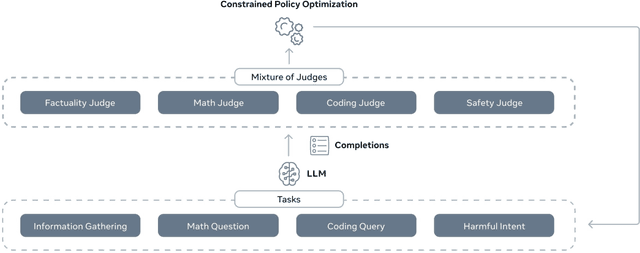
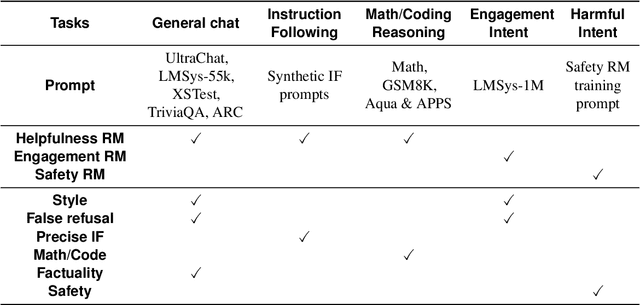
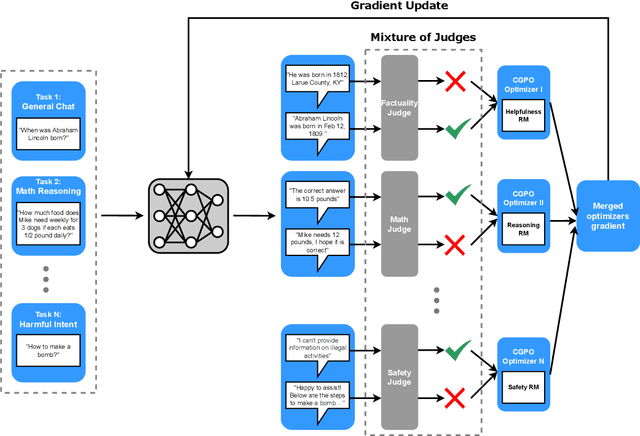
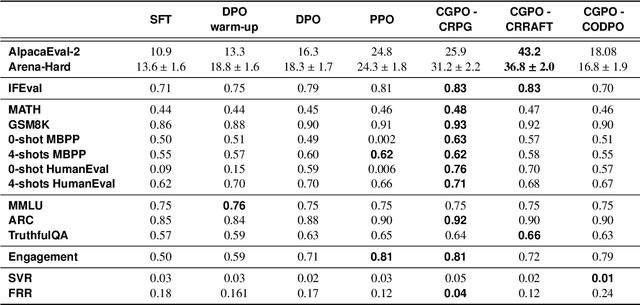
Abstract:Reinforcement learning from human feedback (RLHF) has become the leading approach for fine-tuning large language models (LLM). However, RLHF has limitations in multi-task learning (MTL) due to challenges of reward hacking and extreme multi-objective optimization (i.e., trade-off of multiple and/or sometimes conflicting objectives). Applying RLHF for MTL currently requires careful tuning of the weights for reward model and data combinations. This is often done via human intuition and does not generalize. In this work, we introduce a novel post-training paradigm which we called Constrained Generative Policy Optimization (CGPO). The core of CGPO is Mixture of Judges (MoJ) with cost-efficient constrained policy optimization with stratification, which can identify the perfect blend in RLHF in a principled manner. It shows strong empirical results with theoretical guarantees, does not require extensive hyper-parameter tuning, and is plug-and-play in common post-training pipelines. Together, this can detect and mitigate reward hacking behaviors while reaching a pareto-optimal point across an extremely large number of objectives. Our empirical evaluations demonstrate that CGPO significantly outperforms standard RLHF algorithms like PPO and DPO across various tasks including general chat, STEM questions, instruction following, and coding. Specifically, CGPO shows improvements of 7.4% in AlpacaEval-2 (general chat), 12.5% in Arena-Hard (STEM & reasoning), and consistent gains in other domains like math and coding. Notably, PPO, while commonly used, is prone to severe reward hacking in popular coding benchmarks, which CGPO successfully addresses. This breakthrough in RLHF not only tackles reward hacking and extreme multi-objective optimization challenges but also advances the state-of-the-art in aligning general-purpose LLMs for diverse applications.
The Llama 3 Herd of Models
Jul 31, 2024Abstract:Modern artificial intelligence (AI) systems are powered by foundation models. This paper presents a new set of foundation models, called Llama 3. It is a herd of language models that natively support multilinguality, coding, reasoning, and tool usage. Our largest model is a dense Transformer with 405B parameters and a context window of up to 128K tokens. This paper presents an extensive empirical evaluation of Llama 3. We find that Llama 3 delivers comparable quality to leading language models such as GPT-4 on a plethora of tasks. We publicly release Llama 3, including pre-trained and post-trained versions of the 405B parameter language model and our Llama Guard 3 model for input and output safety. The paper also presents the results of experiments in which we integrate image, video, and speech capabilities into Llama 3 via a compositional approach. We observe this approach performs competitively with the state-of-the-art on image, video, and speech recognition tasks. The resulting models are not yet being broadly released as they are still under development.
On the Equivalence of Graph Convolution and Mixup
Sep 29, 2023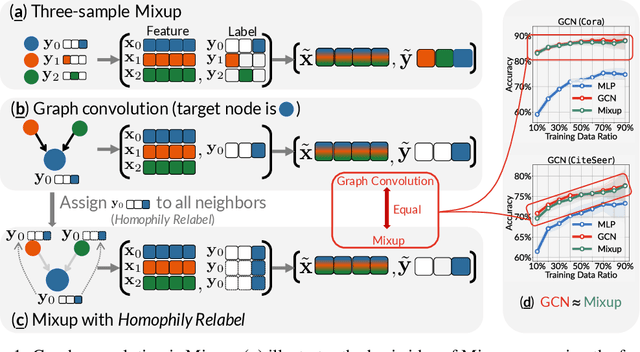
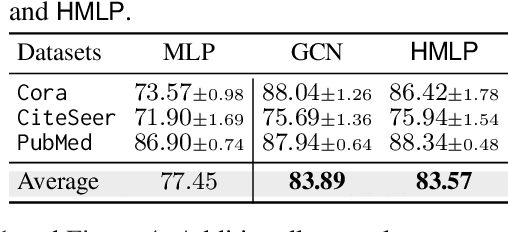

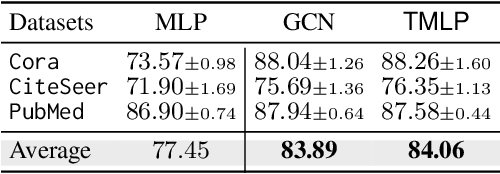
Abstract:This paper investigates the relationship between graph convolution and Mixup techniques. Graph convolution in a graph neural network involves aggregating features from neighboring samples to learn representative features for a specific node or sample. On the other hand, Mixup is a data augmentation technique that generates new examples by averaging features and one-hot labels from multiple samples. One commonality between these techniques is their utilization of information from multiple samples to derive feature representation. This study aims to explore whether a connection exists between these two approaches. Our investigation reveals that, under two mild conditions, graph convolution can be viewed as a specialized form of Mixup that is applied during both the training and testing phases. The two conditions are: 1) \textit{Homophily Relabel} - assigning the target node's label to all its neighbors, and 2) \textit{Test-Time Mixup} - Mixup the feature during the test time. We establish this equivalence mathematically by demonstrating that graph convolution networks (GCN) and simplified graph convolution (SGC) can be expressed as a form of Mixup. We also empirically verify the equivalence by training an MLP using the two conditions to achieve comparable performance.
Are Machine Rationales (Not) Useful to Humans? Measuring and Improving Human Utility of Free-Text Rationales
May 11, 2023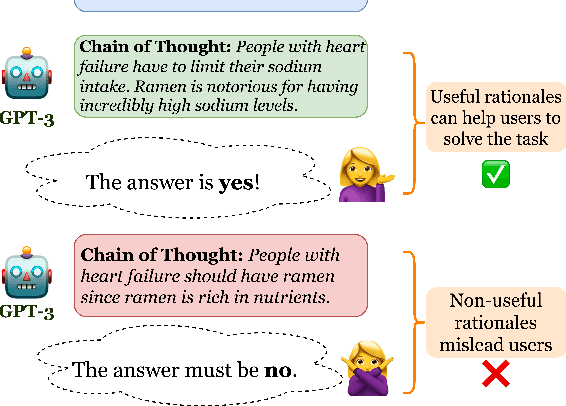
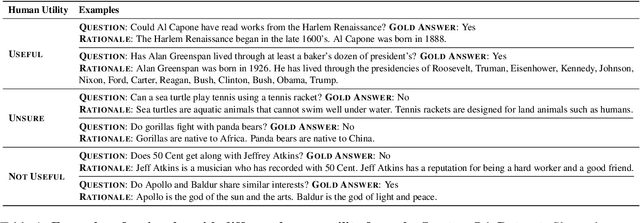

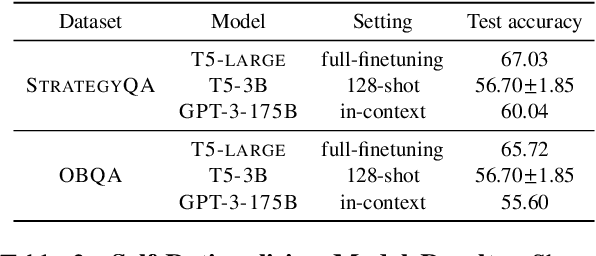
Abstract:Among the remarkable emergent capabilities of large language models (LMs) is free-text rationalization; beyond a certain scale, large LMs are capable of generating seemingly useful rationalizations, which in turn, can dramatically enhance their performances on leaderboards. This phenomenon raises a question: can machine generated rationales also be useful for humans, especially when lay humans try to answer questions based on those machine rationales? We observe that human utility of existing rationales is far from satisfactory, and expensive to estimate with human studies. Existing metrics like task performance of the LM generating the rationales, or similarity between generated and gold rationales are not good indicators of their human utility. While we observe that certain properties of rationales like conciseness and novelty are correlated with their human utility, estimating them without human involvement is challenging. We show that, by estimating a rationale's helpfulness in answering similar unseen instances, we can measure its human utility to a better extent. We also translate this finding into an automated score, GEN-U, that we propose, which can help improve LMs' ability to generate rationales with better human utility, while maintaining most of its task performance. Lastly, we release all code and collected data with this project.
AD-DROP: Attribution-Driven Dropout for Robust Language Model Fine-Tuning
Oct 12, 2022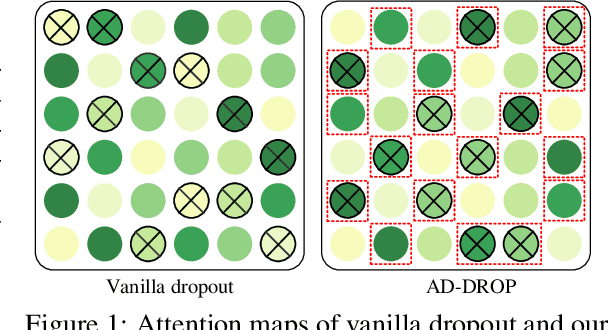
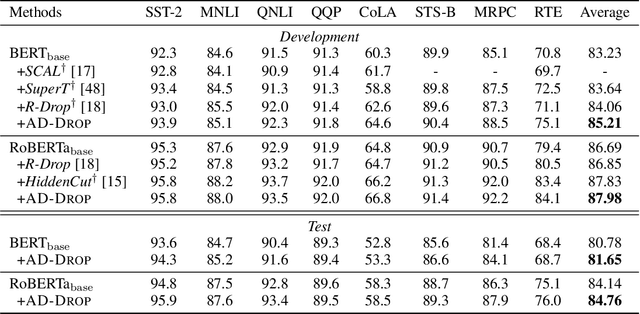
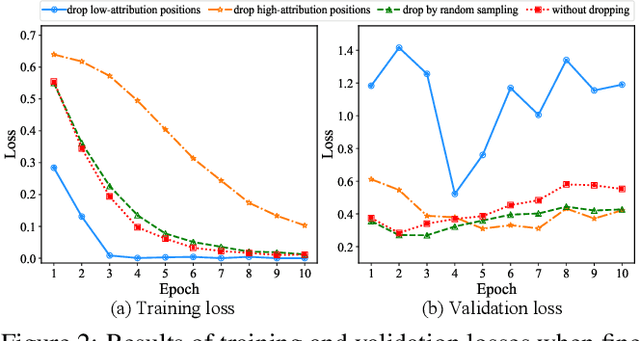
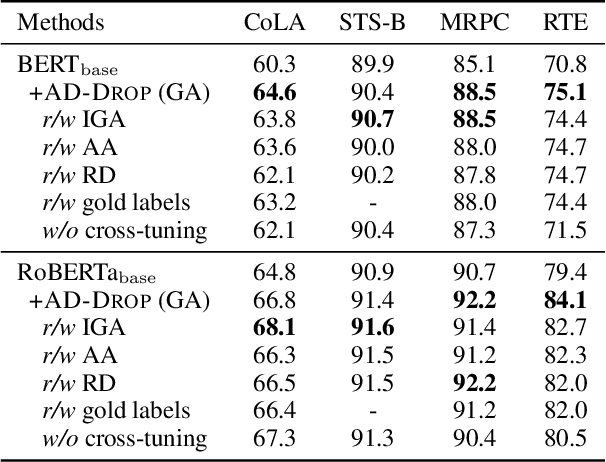
Abstract:Fine-tuning large pre-trained language models on downstream tasks is apt to suffer from overfitting when limited training data is available. While dropout proves to be an effective antidote by randomly dropping a proportion of units, existing research has not examined its effect on the self-attention mechanism. In this paper, we investigate this problem through self-attention attribution and find that dropping attention positions with low attribution scores can accelerate training and increase the risk of overfitting. Motivated by this observation, we propose Attribution-Driven Dropout (AD-DROP), which randomly discards some high-attribution positions to encourage the model to make predictions by relying more on low-attribution positions to reduce overfitting. We also develop a cross-tuning strategy to alternate fine-tuning and AD-DROP to avoid dropping high-attribution positions excessively. Extensive experiments on various benchmarks show that AD-DROP yields consistent improvements over baselines. Analysis further confirms that AD-DROP serves as a strategic regularizer to prevent overfitting during fine-tuning.
FRAME: Evaluating Simulatability Metrics for Free-Text Rationales
Jul 02, 2022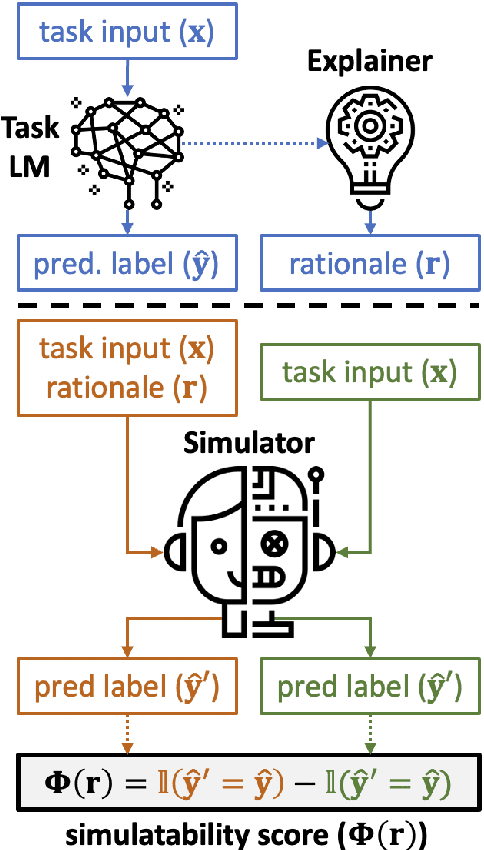
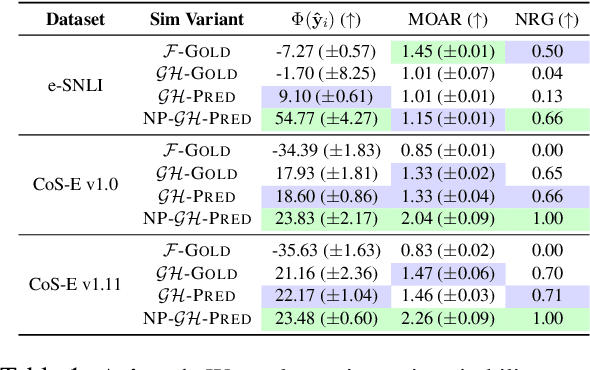
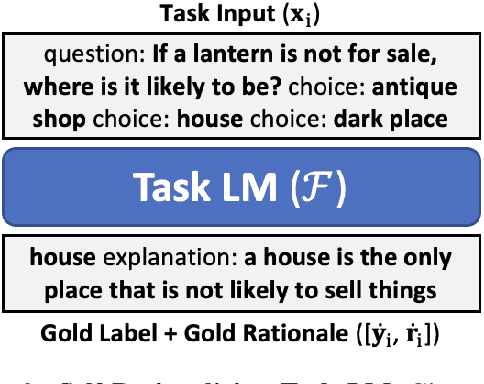
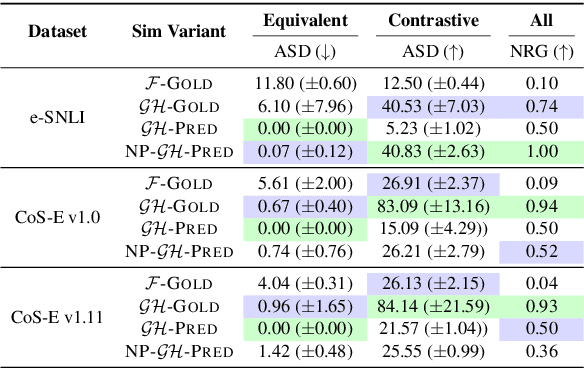
Abstract:Free-text rationales aim to explain neural language model (LM) behavior more flexibly and intuitively via natural language. To ensure rationale quality, it is important to have metrics for measuring rationales' faithfulness (reflects LM's actual behavior) and plausibility (convincing to humans). All existing free-text rationale metrics are based on simulatability (association between rationale and LM's predicted label), but there is no protocol for assessing such metrics' reliability. To investigate this, we propose FRAME, a framework for evaluating free-text rationale simulatability metrics. FRAME is based on three axioms: (1) good metrics should yield highest scores for reference rationales, which maximize rationale-label association by construction; (2) good metrics should be appropriately sensitive to semantic perturbation of rationales; and (3) good metrics should be robust to variation in the LM's task performance. Across three text classification datasets, we show that existing simulatability metrics cannot satisfy all three FRAME axioms, since they are implemented via model pretraining which muddles the metric's signal. We introduce a non-pretraining simulatability variant that improves performance on (1) and (3) by an average of 41.7% and 42.9%, respectively, while performing competitively on (2).
ER-TEST: Evaluating Explanation Regularization Methods for NLP Models
May 25, 2022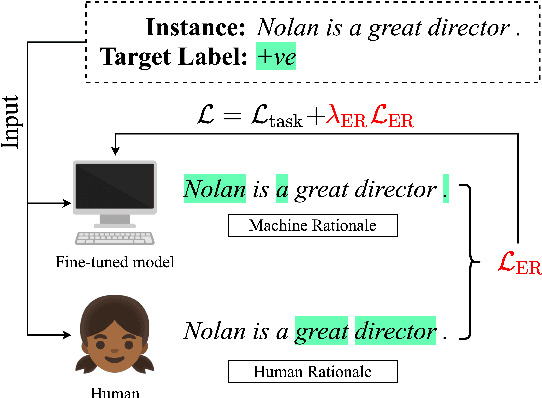



Abstract:Neural language models' (NLMs') reasoning processes are notoriously hard to explain. Recently, there has been much progress in automatically generating machine rationales of NLM behavior, but less in utilizing the rationales to improve NLM behavior. For the latter, explanation regularization (ER) aims to improve NLM generalization by pushing the machine rationales to align with human rationales. Whereas prior works primarily evaluate such ER models via in-distribution (ID) generalization, ER's impact on out-of-distribution (OOD) is largely underexplored. Plus, little is understood about how ER model performance is affected by the choice of ER criteria or by the number/choice of training instances with human rationales. In light of this, we propose ER-TEST, a protocol for evaluating ER models' OOD generalization along three dimensions: (1) unseen datasets, (2) contrast set tests, and (3) functional tests. Using ER-TEST, we study three key questions: (A) Which ER criteria are most effective for the given OOD setting? (B) How is ER affected by the number/choice of training instances with human rationales? (C) Is ER effective with distantly supervised human rationales? ER-TEST enables comprehensive analysis of these questions by considering a diverse range of tasks and datasets. Through ER-TEST, we show that ER has little impact on ID performance, but can yield large gains on OOD performance w.r.t. (1)-(3). Also, we find that the best ER criterion is task-dependent, while ER can improve OOD performance even with limited and distantly-supervised human rationales.
 Add to Chrome
Add to Chrome Add to Firefox
Add to Firefox Add to Edge
Add to Edge